Project Report: Financial Analysis and Risk Assessment of CS Energy
VerifiedAdded on 2021/06/17
|10
|2147
|64
Project
AI Summary
This project report presents a comprehensive financial analysis of CS Energy's proposed new power station. The report begins with an introduction to the case study, followed by a risk assessment analysis that considers the potential threats to the project. The core of the analysis involves both quantitative and qualitative assessments. The quantitative analysis employs capital budgeting techniques such as Net Present Value (NPV), Internal Rate of Return (IRR), Payback Period, and Profitability Index to evaluate the project's financial viability. The qualitative analysis examines the non-numerical factors, including the impact on electricity delivery, market position, and operational costs. The report concludes with a justification, summarizing the findings and recommending whether the project should be approved, considering the trade-offs between the IRR and the cost of capital. The analysis suggests that although the project offers positive returns, the company should consider its cost of capital before making a final investment decision. The project's payback period, profitability index, and cash flow analysis are all discussed in detail.

Running Head: Case study in Finance
1
Project Report: Case study in finance
1
Project Report: Case study in finance
Paraphrase This Document
Need a fresh take? Get an instant paraphrase of this document with our AI Paraphraser
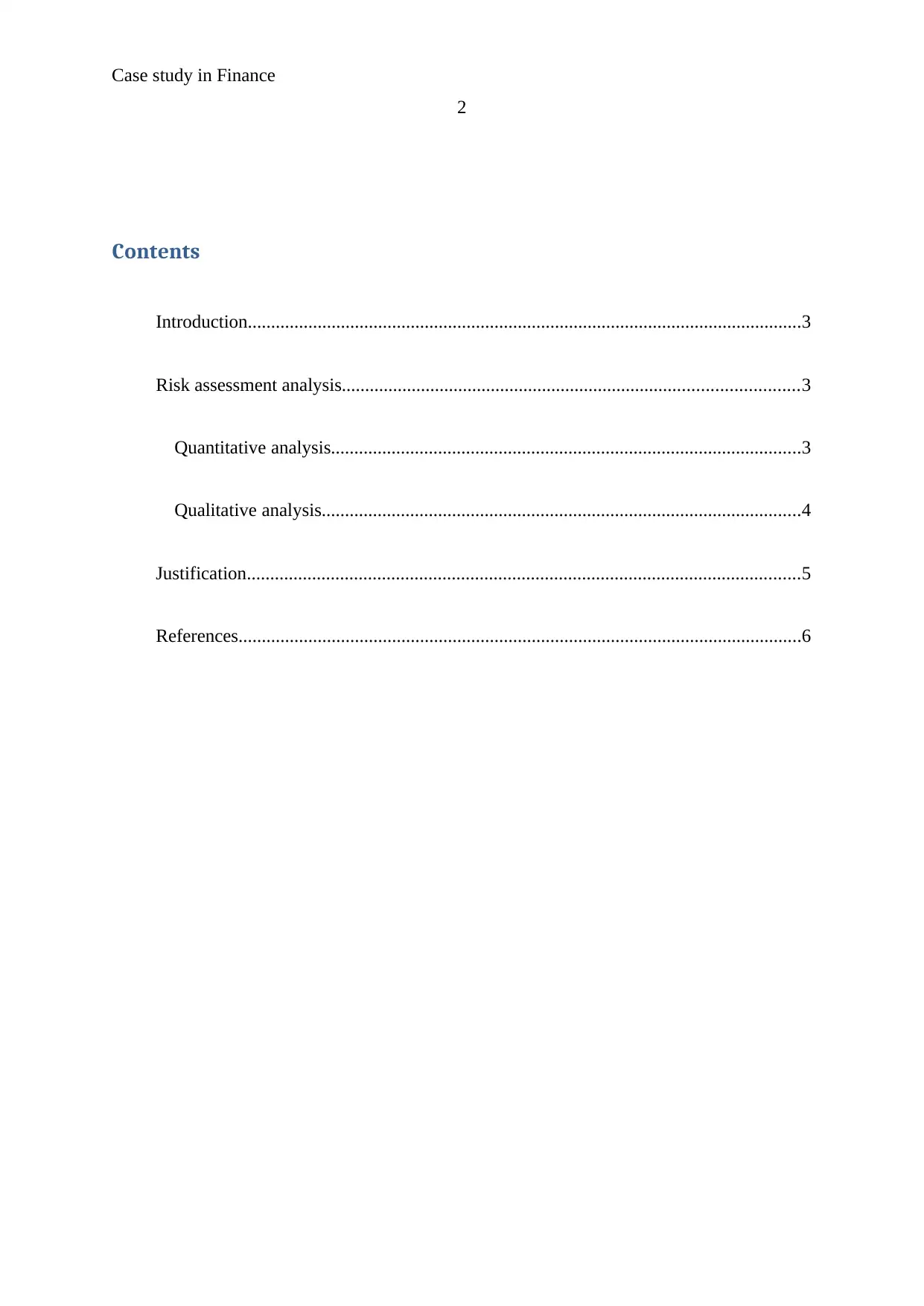
Case study in Finance
2
Contents
Introduction.......................................................................................................................3
Risk assessment analysis..................................................................................................3
Quantitative analysis.....................................................................................................3
Qualitative analysis.......................................................................................................4
Justification.......................................................................................................................5
References.........................................................................................................................6
2
Contents
Introduction.......................................................................................................................3
Risk assessment analysis..................................................................................................3
Quantitative analysis.....................................................................................................3
Qualitative analysis.......................................................................................................4
Justification.......................................................................................................................5
References.........................................................................................................................6
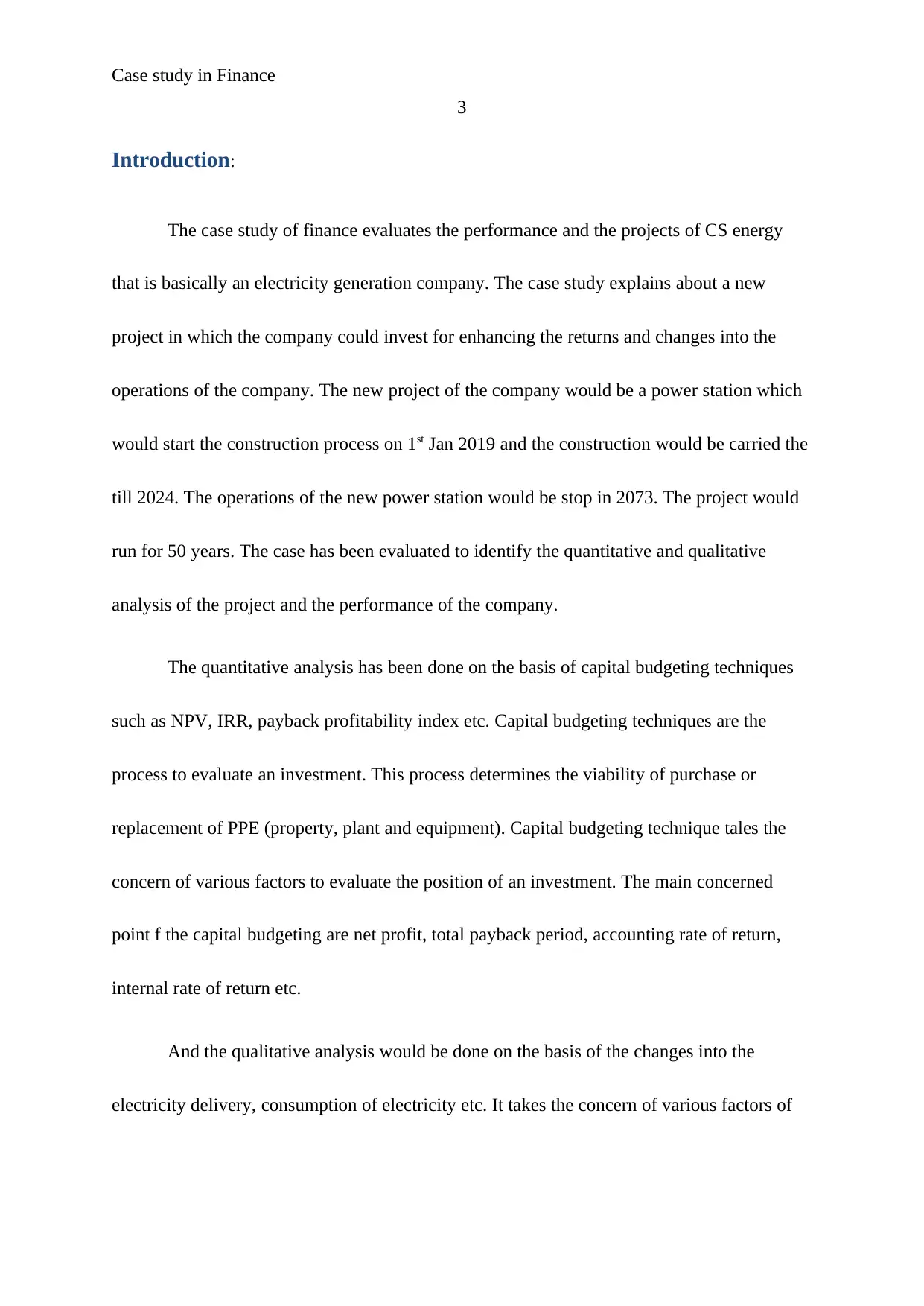
Case study in Finance
3
Introduction:
The case study of finance evaluates the performance and the projects of CS energy
that is basically an electricity generation company. The case study explains about a new
project in which the company could invest for enhancing the returns and changes into the
operations of the company. The new project of the company would be a power station which
would start the construction process on 1st Jan 2019 and the construction would be carried the
till 2024. The operations of the new power station would be stop in 2073. The project would
run for 50 years. The case has been evaluated to identify the quantitative and qualitative
analysis of the project and the performance of the company.
The quantitative analysis has been done on the basis of capital budgeting techniques
such as NPV, IRR, payback profitability index etc. Capital budgeting techniques are the
process to evaluate an investment. This process determines the viability of purchase or
replacement of PPE (property, plant and equipment). Capital budgeting technique tales the
concern of various factors to evaluate the position of an investment. The main concerned
point f the capital budgeting are net profit, total payback period, accounting rate of return,
internal rate of return etc.
And the qualitative analysis would be done on the basis of the changes into the
electricity delivery, consumption of electricity etc. It takes the concern of various factors of
3
Introduction:
The case study of finance evaluates the performance and the projects of CS energy
that is basically an electricity generation company. The case study explains about a new
project in which the company could invest for enhancing the returns and changes into the
operations of the company. The new project of the company would be a power station which
would start the construction process on 1st Jan 2019 and the construction would be carried the
till 2024. The operations of the new power station would be stop in 2073. The project would
run for 50 years. The case has been evaluated to identify the quantitative and qualitative
analysis of the project and the performance of the company.
The quantitative analysis has been done on the basis of capital budgeting techniques
such as NPV, IRR, payback profitability index etc. Capital budgeting techniques are the
process to evaluate an investment. This process determines the viability of purchase or
replacement of PPE (property, plant and equipment). Capital budgeting technique tales the
concern of various factors to evaluate the position of an investment. The main concerned
point f the capital budgeting are net profit, total payback period, accounting rate of return,
internal rate of return etc.
And the qualitative analysis would be done on the basis of the changes into the
electricity delivery, consumption of electricity etc. It takes the concern of various factors of
⊘ This is a preview!⊘
Do you want full access?
Subscribe today to unlock all pages.

Trusted by 1+ million students worldwide
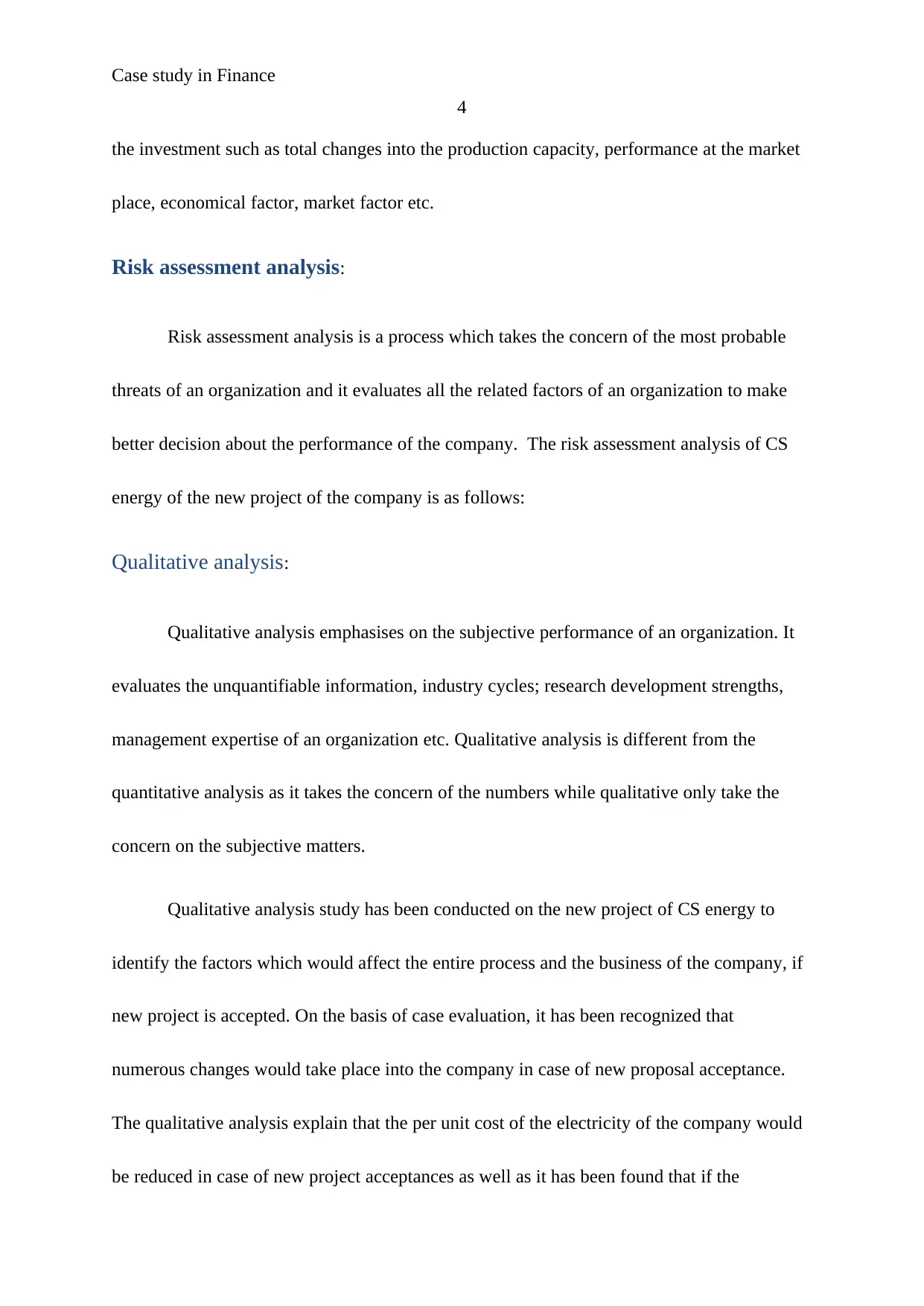
Case study in Finance
4
the investment such as total changes into the production capacity, performance at the market
place, economical factor, market factor etc.
Risk assessment analysis:
Risk assessment analysis is a process which takes the concern of the most probable
threats of an organization and it evaluates all the related factors of an organization to make
better decision about the performance of the company. The risk assessment analysis of CS
energy of the new project of the company is as follows:
Qualitative analysis:
Qualitative analysis emphasises on the subjective performance of an organization. It
evaluates the unquantifiable information, industry cycles; research development strengths,
management expertise of an organization etc. Qualitative analysis is different from the
quantitative analysis as it takes the concern of the numbers while qualitative only take the
concern on the subjective matters.
Qualitative analysis study has been conducted on the new project of CS energy to
identify the factors which would affect the entire process and the business of the company, if
new project is accepted. On the basis of case evaluation, it has been recognized that
numerous changes would take place into the company in case of new proposal acceptance.
The qualitative analysis explain that the per unit cost of the electricity of the company would
be reduced in case of new project acceptances as well as it has been found that if the
4
the investment such as total changes into the production capacity, performance at the market
place, economical factor, market factor etc.
Risk assessment analysis:
Risk assessment analysis is a process which takes the concern of the most probable
threats of an organization and it evaluates all the related factors of an organization to make
better decision about the performance of the company. The risk assessment analysis of CS
energy of the new project of the company is as follows:
Qualitative analysis:
Qualitative analysis emphasises on the subjective performance of an organization. It
evaluates the unquantifiable information, industry cycles; research development strengths,
management expertise of an organization etc. Qualitative analysis is different from the
quantitative analysis as it takes the concern of the numbers while qualitative only take the
concern on the subjective matters.
Qualitative analysis study has been conducted on the new project of CS energy to
identify the factors which would affect the entire process and the business of the company, if
new project is accepted. On the basis of case evaluation, it has been recognized that
numerous changes would take place into the company in case of new proposal acceptance.
The qualitative analysis explain that the per unit cost of the electricity of the company would
be reduced in case of new project acceptances as well as it has been found that if the
Paraphrase This Document
Need a fresh take? Get an instant paraphrase of this document with our AI Paraphraser
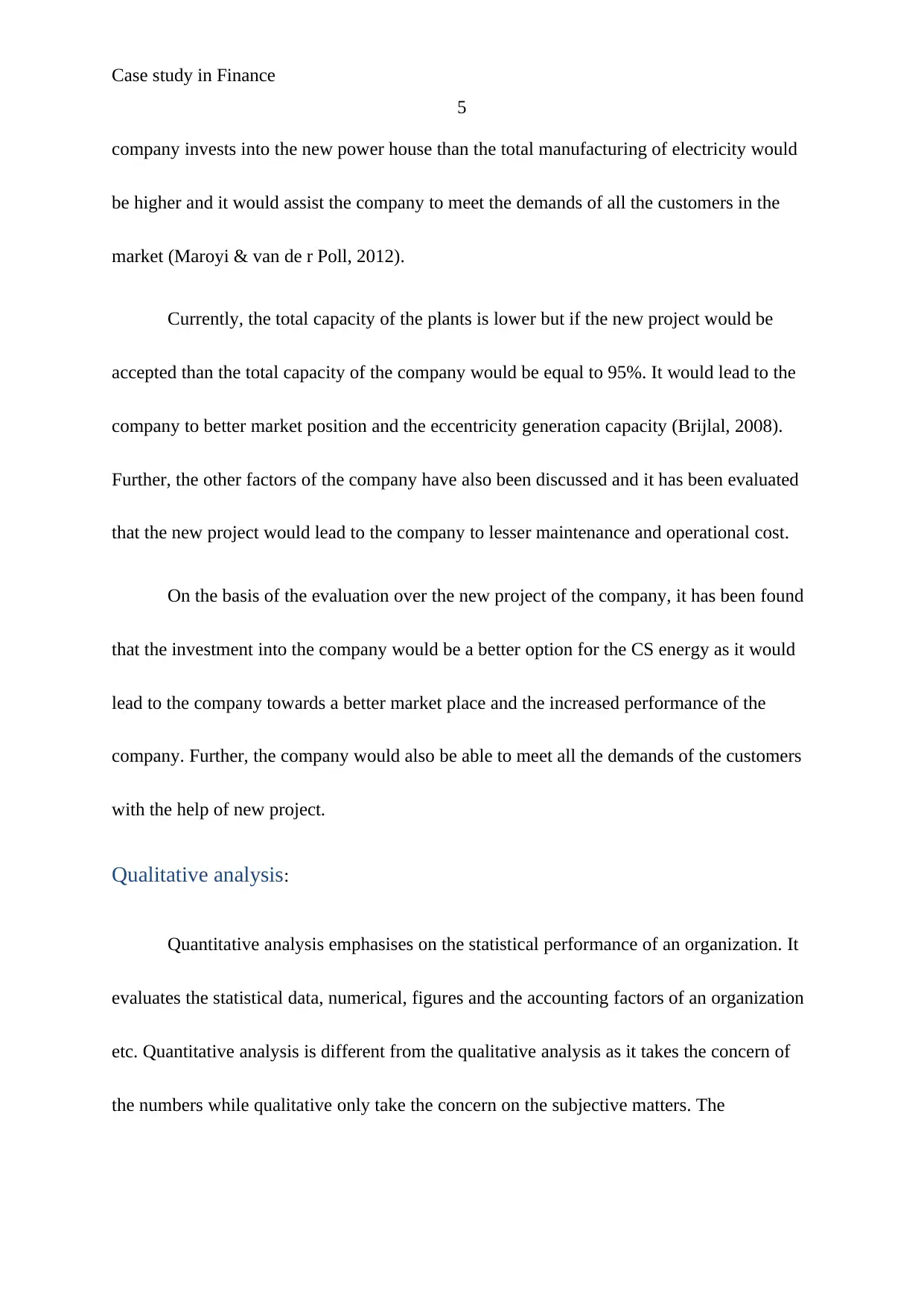
Case study in Finance
5
company invests into the new power house than the total manufacturing of electricity would
be higher and it would assist the company to meet the demands of all the customers in the
market (Maroyi & van de r Poll, 2012).
Currently, the total capacity of the plants is lower but if the new project would be
accepted than the total capacity of the company would be equal to 95%. It would lead to the
company to better market position and the eccentricity generation capacity (Brijlal, 2008).
Further, the other factors of the company have also been discussed and it has been evaluated
that the new project would lead to the company to lesser maintenance and operational cost.
On the basis of the evaluation over the new project of the company, it has been found
that the investment into the company would be a better option for the CS energy as it would
lead to the company towards a better market place and the increased performance of the
company. Further, the company would also be able to meet all the demands of the customers
with the help of new project.
Qualitative analysis:
Quantitative analysis emphasises on the statistical performance of an organization. It
evaluates the statistical data, numerical, figures and the accounting factors of an organization
etc. Quantitative analysis is different from the qualitative analysis as it takes the concern of
the numbers while qualitative only take the concern on the subjective matters. The
5
company invests into the new power house than the total manufacturing of electricity would
be higher and it would assist the company to meet the demands of all the customers in the
market (Maroyi & van de r Poll, 2012).
Currently, the total capacity of the plants is lower but if the new project would be
accepted than the total capacity of the company would be equal to 95%. It would lead to the
company to better market position and the eccentricity generation capacity (Brijlal, 2008).
Further, the other factors of the company have also been discussed and it has been evaluated
that the new project would lead to the company to lesser maintenance and operational cost.
On the basis of the evaluation over the new project of the company, it has been found
that the investment into the company would be a better option for the CS energy as it would
lead to the company towards a better market place and the increased performance of the
company. Further, the company would also be able to meet all the demands of the customers
with the help of new project.
Qualitative analysis:
Quantitative analysis emphasises on the statistical performance of an organization. It
evaluates the statistical data, numerical, figures and the accounting factors of an organization
etc. Quantitative analysis is different from the qualitative analysis as it takes the concern of
the numbers while qualitative only take the concern on the subjective matters. The
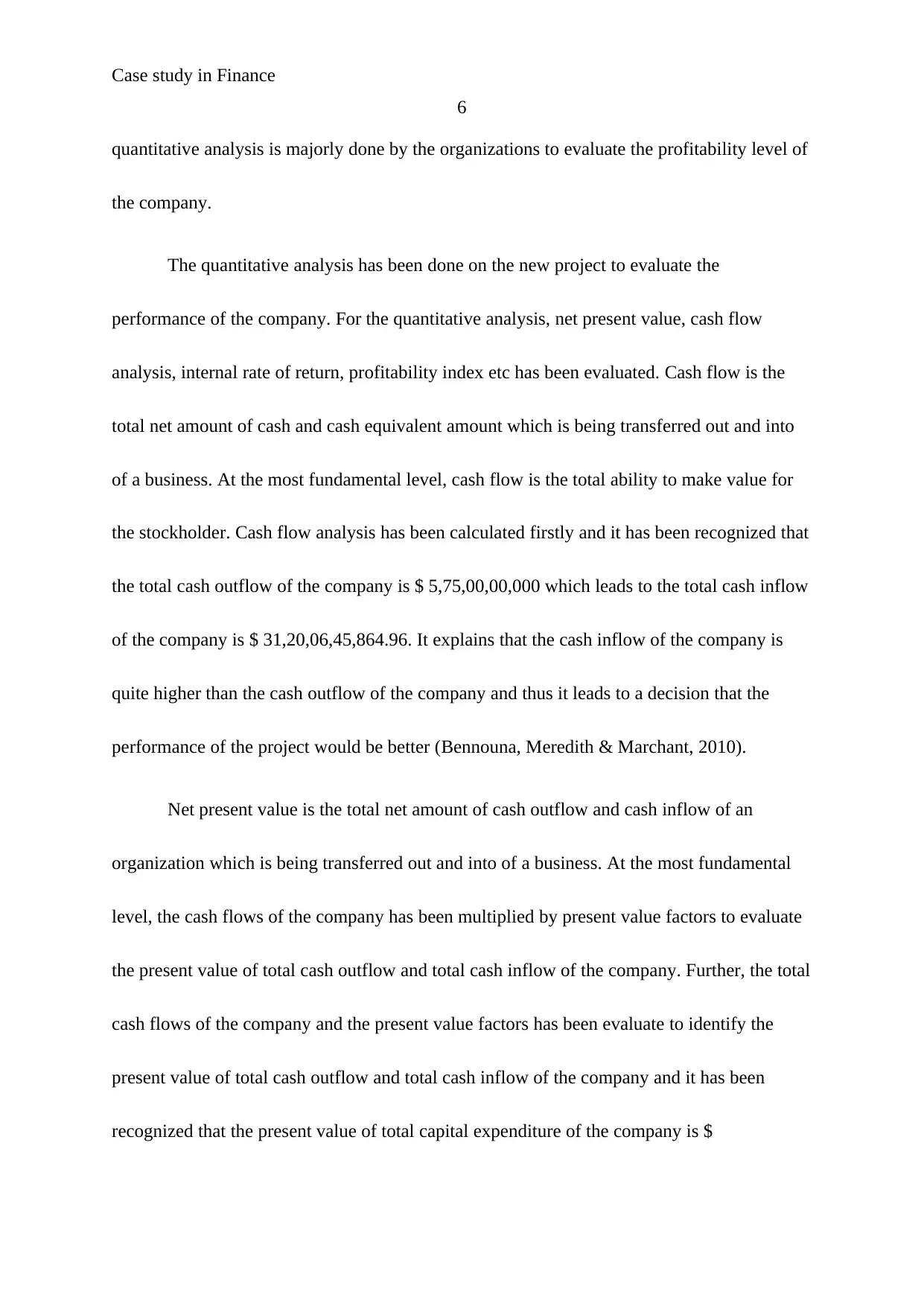
Case study in Finance
6
quantitative analysis is majorly done by the organizations to evaluate the profitability level of
the company.
The quantitative analysis has been done on the new project to evaluate the
performance of the company. For the quantitative analysis, net present value, cash flow
analysis, internal rate of return, profitability index etc has been evaluated. Cash flow is the
total net amount of cash and cash equivalent amount which is being transferred out and into
of a business. At the most fundamental level, cash flow is the total ability to make value for
the stockholder. Cash flow analysis has been calculated firstly and it has been recognized that
the total cash outflow of the company is $ 5,75,00,00,000 which leads to the total cash inflow
of the company is $ 31,20,06,45,864.96. It explains that the cash inflow of the company is
quite higher than the cash outflow of the company and thus it leads to a decision that the
performance of the project would be better (Bennouna, Meredith & Marchant, 2010).
Net present value is the total net amount of cash outflow and cash inflow of an
organization which is being transferred out and into of a business. At the most fundamental
level, the cash flows of the company has been multiplied by present value factors to evaluate
the present value of total cash outflow and total cash inflow of the company. Further, the total
cash flows of the company and the present value factors has been evaluate to identify the
present value of total cash outflow and total cash inflow of the company and it has been
recognized that the present value of total capital expenditure of the company is $
6
quantitative analysis is majorly done by the organizations to evaluate the profitability level of
the company.
The quantitative analysis has been done on the new project to evaluate the
performance of the company. For the quantitative analysis, net present value, cash flow
analysis, internal rate of return, profitability index etc has been evaluated. Cash flow is the
total net amount of cash and cash equivalent amount which is being transferred out and into
of a business. At the most fundamental level, cash flow is the total ability to make value for
the stockholder. Cash flow analysis has been calculated firstly and it has been recognized that
the total cash outflow of the company is $ 5,75,00,00,000 which leads to the total cash inflow
of the company is $ 31,20,06,45,864.96. It explains that the cash inflow of the company is
quite higher than the cash outflow of the company and thus it leads to a decision that the
performance of the project would be better (Bennouna, Meredith & Marchant, 2010).
Net present value is the total net amount of cash outflow and cash inflow of an
organization which is being transferred out and into of a business. At the most fundamental
level, the cash flows of the company has been multiplied by present value factors to evaluate
the present value of total cash outflow and total cash inflow of the company. Further, the total
cash flows of the company and the present value factors has been evaluate to identify the
present value of total cash outflow and total cash inflow of the company and it has been
recognized that the present value of total capital expenditure of the company is $
⊘ This is a preview!⊘
Do you want full access?
Subscribe today to unlock all pages.

Trusted by 1+ million students worldwide

Case study in Finance
7
43,91,13,55,421.28 whereas the total present value of the net cash inflow of the company is $
5,61,88,65,204.03 (Bierman & Smidt, 2012). It explains that total net present value of the
project is $ 1227729782.75. It explains that the project would offer positive returns to the
company and thus the project must be accepted.
In addition, the profitability index of the project has also been evaluated. Profitability
index is the factor of capital budgeting which explains about the total cash inflow of the
company in concern with the total cash outflow of the company. On the basis of the
calculation of profitability index, it has been found that the net cash inflow of the company is
1.28 times higher than the net cash outflow of the company. It leads that the performance of
the company is better and the inflows are also higher. It explains that the investment would
be profitable for the company. Further, the payback period has been evaluated. Payback
period is the factor of capital budgeting which explains about the total time of the company in
which the total cash outflow of the company would be get back. On the basis of the
calculation of payback period, it has been recognized that the total cash outflow world be get
back by the company in 15.57 years. However the total life of project is 50 year (Truong,
Partington & Peat, 2008). It explains that the investment would be profitable for the company
and company should accept it.
Lastly, the internal rate of return of the project has been evaluated. Internal rate of
return is the factor of capital budgeting which explains about the total return when the NPV
7
43,91,13,55,421.28 whereas the total present value of the net cash inflow of the company is $
5,61,88,65,204.03 (Bierman & Smidt, 2012). It explains that total net present value of the
project is $ 1227729782.75. It explains that the project would offer positive returns to the
company and thus the project must be accepted.
In addition, the profitability index of the project has also been evaluated. Profitability
index is the factor of capital budgeting which explains about the total cash inflow of the
company in concern with the total cash outflow of the company. On the basis of the
calculation of profitability index, it has been found that the net cash inflow of the company is
1.28 times higher than the net cash outflow of the company. It leads that the performance of
the company is better and the inflows are also higher. It explains that the investment would
be profitable for the company. Further, the payback period has been evaluated. Payback
period is the factor of capital budgeting which explains about the total time of the company in
which the total cash outflow of the company would be get back. On the basis of the
calculation of payback period, it has been recognized that the total cash outflow world be get
back by the company in 15.57 years. However the total life of project is 50 year (Truong,
Partington & Peat, 2008). It explains that the investment would be profitable for the company
and company should accept it.
Lastly, the internal rate of return of the project has been evaluated. Internal rate of
return is the factor of capital budgeting which explains about the total return when the NPV
Paraphrase This Document
Need a fresh take? Get an instant paraphrase of this document with our AI Paraphraser
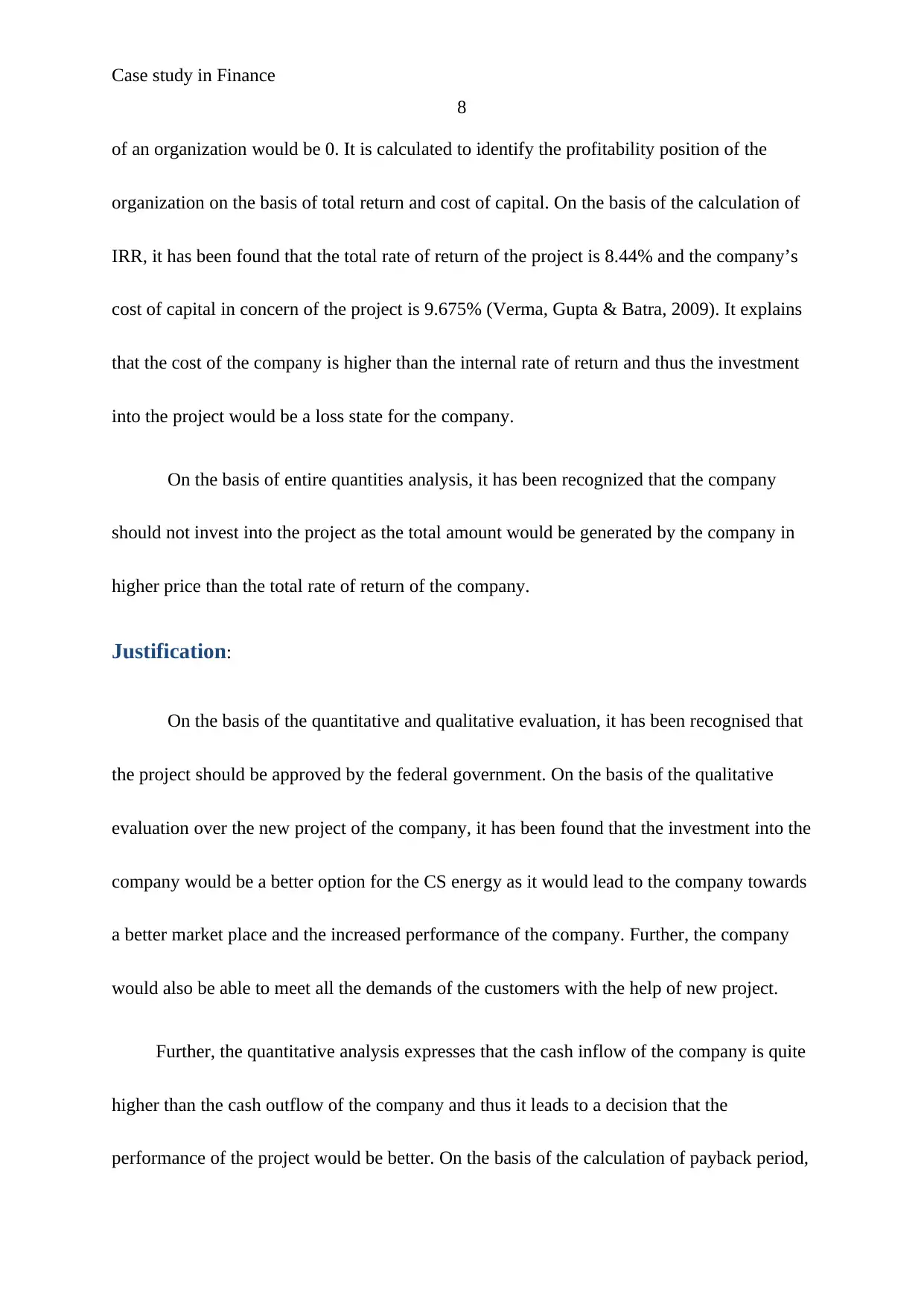
Case study in Finance
8
of an organization would be 0. It is calculated to identify the profitability position of the
organization on the basis of total return and cost of capital. On the basis of the calculation of
IRR, it has been found that the total rate of return of the project is 8.44% and the company’s
cost of capital in concern of the project is 9.675% (Verma, Gupta & Batra, 2009). It explains
that the cost of the company is higher than the internal rate of return and thus the investment
into the project would be a loss state for the company.
On the basis of entire quantities analysis, it has been recognized that the company
should not invest into the project as the total amount would be generated by the company in
higher price than the total rate of return of the company.
Justification:
On the basis of the quantitative and qualitative evaluation, it has been recognised that
the project should be approved by the federal government. On the basis of the qualitative
evaluation over the new project of the company, it has been found that the investment into the
company would be a better option for the CS energy as it would lead to the company towards
a better market place and the increased performance of the company. Further, the company
would also be able to meet all the demands of the customers with the help of new project.
Further, the quantitative analysis expresses that the cash inflow of the company is quite
higher than the cash outflow of the company and thus it leads to a decision that the
performance of the project would be better. On the basis of the calculation of payback period,
8
of an organization would be 0. It is calculated to identify the profitability position of the
organization on the basis of total return and cost of capital. On the basis of the calculation of
IRR, it has been found that the total rate of return of the project is 8.44% and the company’s
cost of capital in concern of the project is 9.675% (Verma, Gupta & Batra, 2009). It explains
that the cost of the company is higher than the internal rate of return and thus the investment
into the project would be a loss state for the company.
On the basis of entire quantities analysis, it has been recognized that the company
should not invest into the project as the total amount would be generated by the company in
higher price than the total rate of return of the company.
Justification:
On the basis of the quantitative and qualitative evaluation, it has been recognised that
the project should be approved by the federal government. On the basis of the qualitative
evaluation over the new project of the company, it has been found that the investment into the
company would be a better option for the CS energy as it would lead to the company towards
a better market place and the increased performance of the company. Further, the company
would also be able to meet all the demands of the customers with the help of new project.
Further, the quantitative analysis expresses that the cash inflow of the company is quite
higher than the cash outflow of the company and thus it leads to a decision that the
performance of the project would be better. On the basis of the calculation of payback period,
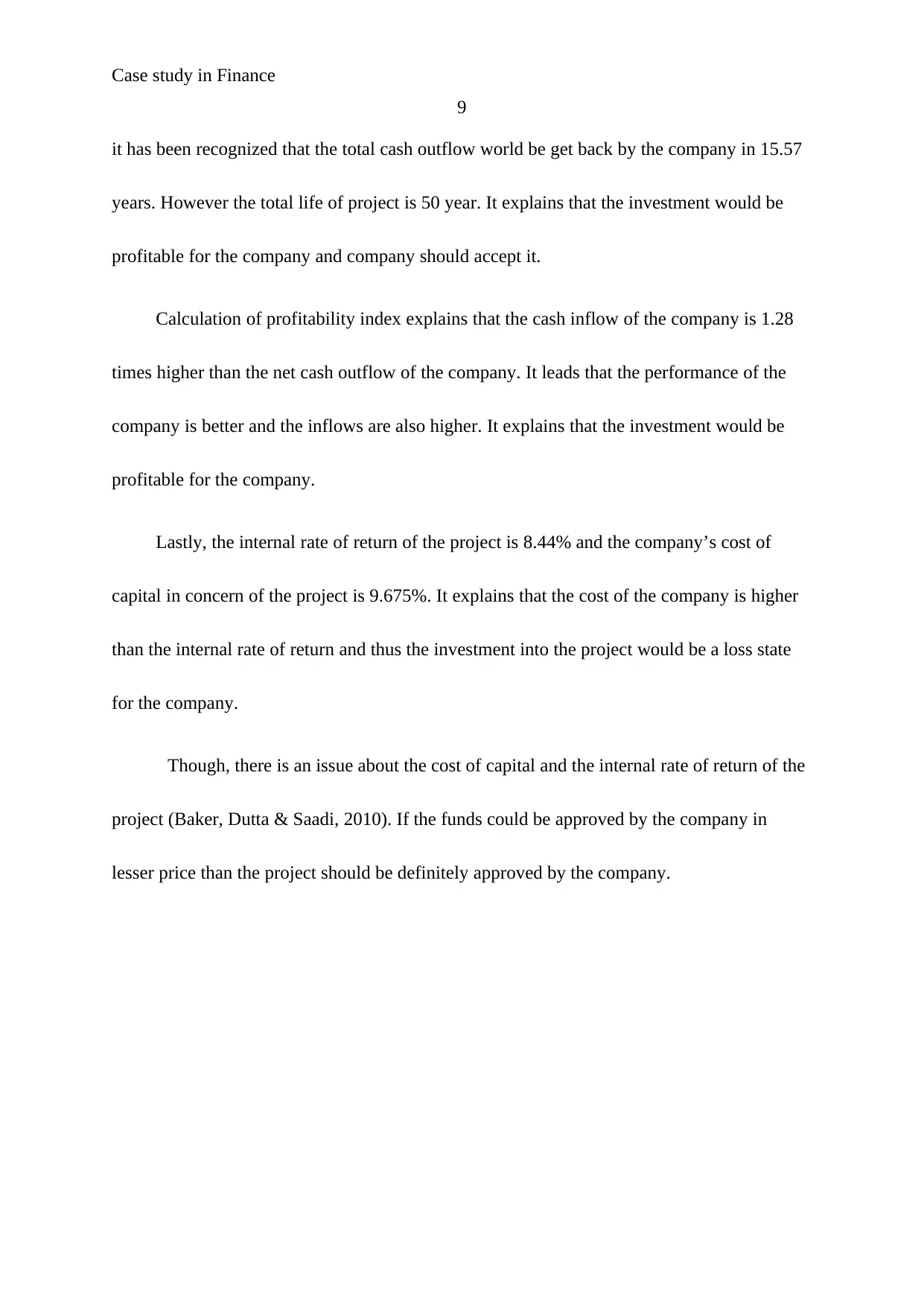
Case study in Finance
9
it has been recognized that the total cash outflow world be get back by the company in 15.57
years. However the total life of project is 50 year. It explains that the investment would be
profitable for the company and company should accept it.
Calculation of profitability index explains that the cash inflow of the company is 1.28
times higher than the net cash outflow of the company. It leads that the performance of the
company is better and the inflows are also higher. It explains that the investment would be
profitable for the company.
Lastly, the internal rate of return of the project is 8.44% and the company’s cost of
capital in concern of the project is 9.675%. It explains that the cost of the company is higher
than the internal rate of return and thus the investment into the project would be a loss state
for the company.
Though, there is an issue about the cost of capital and the internal rate of return of the
project (Baker, Dutta & Saadi, 2010). If the funds could be approved by the company in
lesser price than the project should be definitely approved by the company.
9
it has been recognized that the total cash outflow world be get back by the company in 15.57
years. However the total life of project is 50 year. It explains that the investment would be
profitable for the company and company should accept it.
Calculation of profitability index explains that the cash inflow of the company is 1.28
times higher than the net cash outflow of the company. It leads that the performance of the
company is better and the inflows are also higher. It explains that the investment would be
profitable for the company.
Lastly, the internal rate of return of the project is 8.44% and the company’s cost of
capital in concern of the project is 9.675%. It explains that the cost of the company is higher
than the internal rate of return and thus the investment into the project would be a loss state
for the company.
Though, there is an issue about the cost of capital and the internal rate of return of the
project (Baker, Dutta & Saadi, 2010). If the funds could be approved by the company in
lesser price than the project should be definitely approved by the company.
⊘ This is a preview!⊘
Do you want full access?
Subscribe today to unlock all pages.

Trusted by 1+ million students worldwide
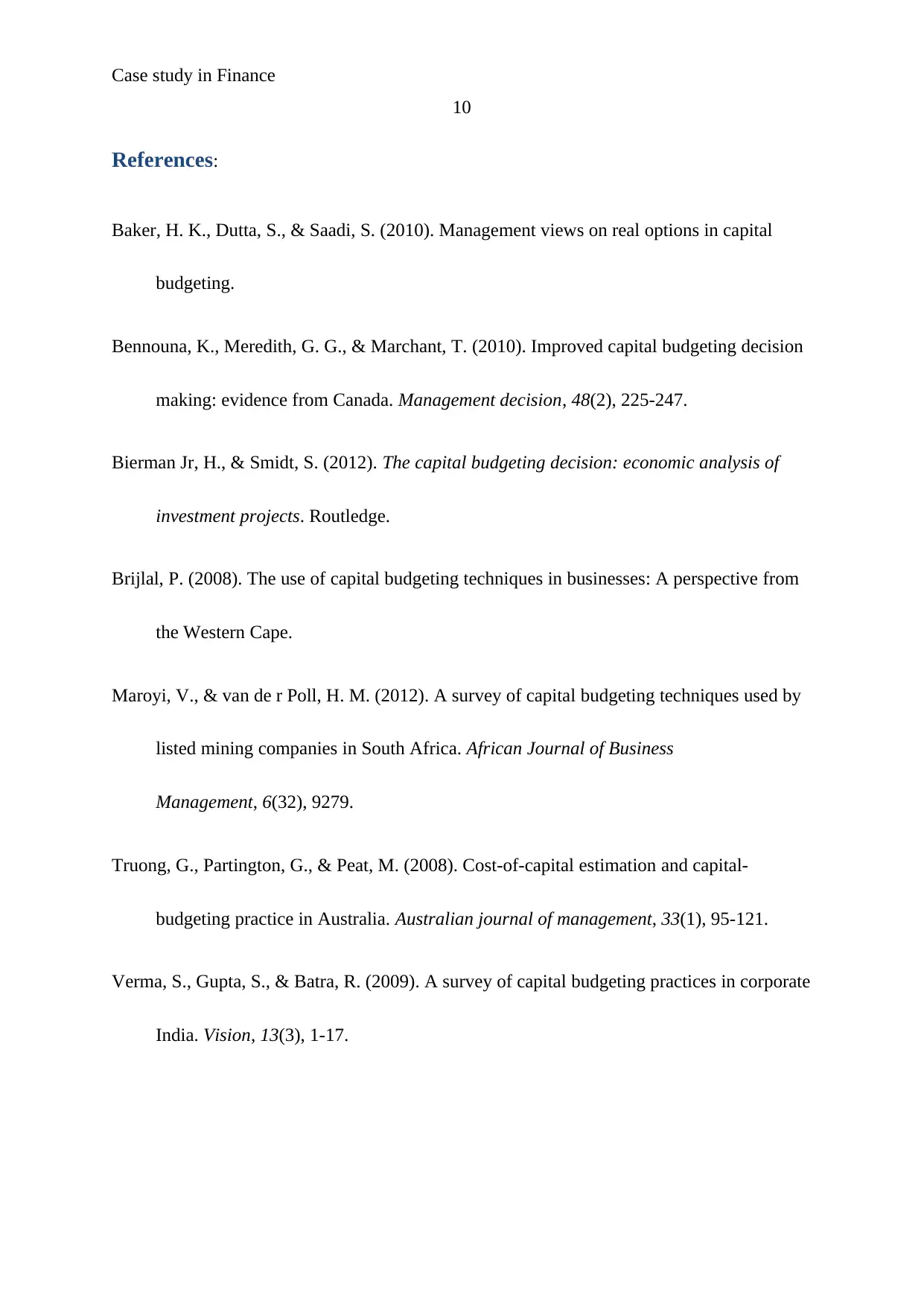
Case study in Finance
10
References:
Baker, H. K., Dutta, S., & Saadi, S. (2010). Management views on real options in capital
budgeting.
Bennouna, K., Meredith, G. G., & Marchant, T. (2010). Improved capital budgeting decision
making: evidence from Canada. Management decision, 48(2), 225-247.
Bierman Jr, H., & Smidt, S. (2012). The capital budgeting decision: economic analysis of
investment projects. Routledge.
Brijlal, P. (2008). The use of capital budgeting techniques in businesses: A perspective from
the Western Cape.
Maroyi, V., & van de r Poll, H. M. (2012). A survey of capital budgeting techniques used by
listed mining companies in South Africa. African Journal of Business
Management, 6(32), 9279.
Truong, G., Partington, G., & Peat, M. (2008). Cost-of-capital estimation and capital-
budgeting practice in Australia. Australian journal of management, 33(1), 95-121.
Verma, S., Gupta, S., & Batra, R. (2009). A survey of capital budgeting practices in corporate
India. Vision, 13(3), 1-17.
10
References:
Baker, H. K., Dutta, S., & Saadi, S. (2010). Management views on real options in capital
budgeting.
Bennouna, K., Meredith, G. G., & Marchant, T. (2010). Improved capital budgeting decision
making: evidence from Canada. Management decision, 48(2), 225-247.
Bierman Jr, H., & Smidt, S. (2012). The capital budgeting decision: economic analysis of
investment projects. Routledge.
Brijlal, P. (2008). The use of capital budgeting techniques in businesses: A perspective from
the Western Cape.
Maroyi, V., & van de r Poll, H. M. (2012). A survey of capital budgeting techniques used by
listed mining companies in South Africa. African Journal of Business
Management, 6(32), 9279.
Truong, G., Partington, G., & Peat, M. (2008). Cost-of-capital estimation and capital-
budgeting practice in Australia. Australian journal of management, 33(1), 95-121.
Verma, S., Gupta, S., & Batra, R. (2009). A survey of capital budgeting practices in corporate
India. Vision, 13(3), 1-17.
1 out of 10
Related Documents
Your All-in-One AI-Powered Toolkit for Academic Success.
+13062052269
info@desklib.com
Available 24*7 on WhatsApp / Email
![[object Object]](/_next/static/media/star-bottom.7253800d.svg)
Unlock your academic potential
Copyright © 2020–2025 A2Z Services. All Rights Reserved. Developed and managed by ZUCOL.





